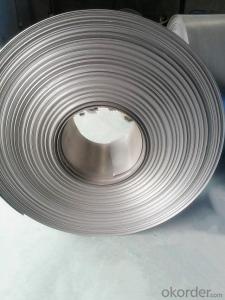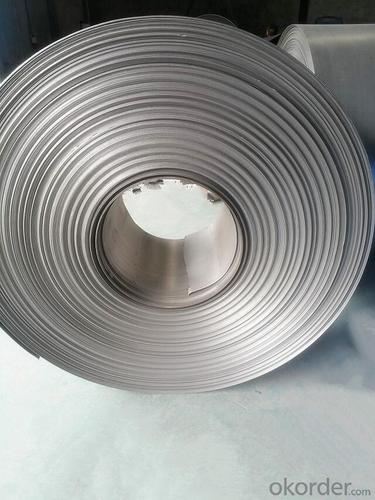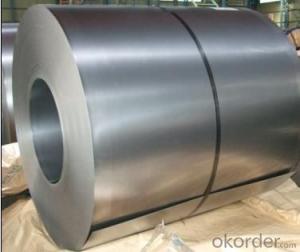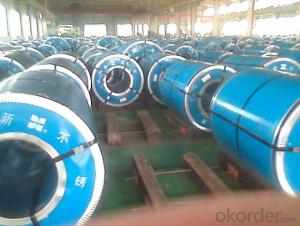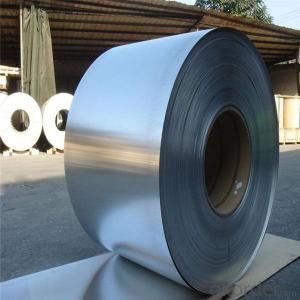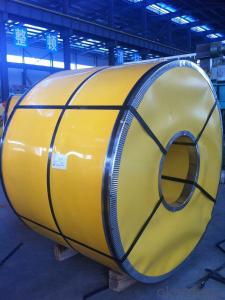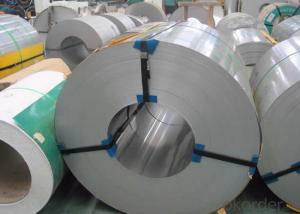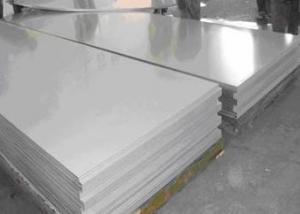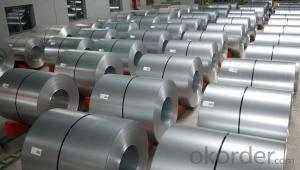304 SERIOUS HOT ROLLED STAINLESS STEEL COILS/SHEETS
- Loading Port:
- Guangzhou
- Payment Terms:
- TT OR LC
- Min Order Qty:
- 100 m.t.
- Supply Capability:
- 20000 m.t./month
OKorder Service Pledge
Quality Product, Order Online Tracking, Timely Delivery
OKorder Financial Service
Credit Rating, Credit Services, Credit Purchasing
You Might Also Like
Quick Details
| Grade: | 300 Series,304 | Standard: | JIS,AISI,ASTM,GB,DIN,EN | Length: | 1000-6000mm |
| Thickness: | 0.3-100mm | Width: | 1000-2000mm | Place of Origin: | foshan |
| Brand Name: | CNBM | Model Number: | 304 | Type: | Coil |
| Application: | construction, building, shipbuilding etc | Certification: | SGS | Surface: | 2B,BA,No.1,No.4,HK,Mirror finish,brush ,hairline |
| Producitivity: | 800Tons/Month | Loading Port: | guangzhou | Main market: | india,Japan,Saudi Arabia,Singapore,Indonesia etc |
| Supply status: | cold rolled and hot rolled |
Packaging & Delivery
| Packaging Detail: | standard export packing stainless steel coil grade 304 |
| Delivery Detail: | 7-10 workdays |
Specifications
1,stainless steel coil grade 304
2,Thickness:0.3-100mm
3.Width:50-3000mm
4,Length:1000-6000
5,Deliver time:5 days
- Q: Can stainless steel strips be cut to custom sizes?
- Indeed, custom sizes can be achieved by cutting stainless steel strips. These strips offer great flexibility and can be effortlessly tailored to desired lengths or widths in order to cater to individual needs. The task can be accomplished through a range of cutting techniques including shearing, laser cutting, or sawing. By customizing the cutting process of stainless steel strips, one can attain precise dimensions, guaranteeing an impeccable match for particular applications or projects.
- Q: Can stainless steel strips be polished to a mirror-like finish?
- Yes, stainless steel strips can be polished to achieve a mirror-like finish. This process involves using progressively finer abrasive materials to remove imperfections and create a smooth, reflective surface.
- Q: How do you prevent microbiologically influenced corrosion of stainless steel strips?
- Microbiologically influenced corrosion (MIC) poses a common problem across various industries, including the corrosion of stainless steel strips. To maintain the integrity of these strips and prevent MIC, it is possible to implement several preventive measures: 1. Opt for Resistant Stainless Steel: Select stainless steel grades that exhibit resistance to MIC, such as 316L or higher-grade alloys. These alloys contain higher levels of molybdenum, which enhances their ability to resist microbiological corrosion. 2. Ensure a Smooth Surface Finish: Guarantee that the stainless steel strips possess a polished and smooth surface finish. Rough surfaces provide crevices and pits that facilitate the thriving of microorganisms and the initiation of corrosion. Consistent cleaning and polishing help maintain surface smoothness. 3. Regular Cleaning and Maintenance: Consistently clean and sanitize the stainless steel strips to eliminate any biofilms or organic matter that may harbor microorganisms. Employ industry-approved cleaning agents and techniques to eradicate potential sources of microbial growth. 4. Employ Biocide Treatments: Apply suitable biocides or antimicrobial coatings to the stainless steel strips. These treatments can impede the growth of microorganisms and prevent corrosion initiation. However, it is crucial to choose biocides that are compatible with stainless steel to avert any adverse reactions. 5. Control the Environment: Maintain appropriate environmental conditions by regulating temperature, humidity, and the presence of corrosive chemicals. Microorganisms thrive in specific conditions, and by managing these factors, microbial growth can be minimized. 6. Implement Cathodic Protection: Introduce cathodic protection techniques, such as impressed current or sacrificial anode systems, to provide an additional layer of corrosion protection. These techniques aid in mitigating the effects of MIC on stainless steel strips. 7. Regularly Inspect and Monitor: Conduct regular inspections to identify any indications of corrosion or microbial growth on stainless steel strips. Establish a monitoring program that encompasses visual inspections, microbiological testing, and corrosion rate measurements to detect early signs of MIC and take appropriate measures. By implementing these preventive measures, the likelihood of microbiologically influenced corrosion on stainless steel strips can be significantly reduced, thereby ensuring their durability and performance.
- Q: What are the factors affecting the creep resistance of 111 stainless steel strips?
- The factors affecting the creep resistance of 111 stainless steel strips include the alloy composition, grain size, temperature, and applied stress. The presence of elements like chromium, nickel, and molybdenum enhances creep resistance. A fine grain structure enhances resistance, while higher temperatures and applied stresses can reduce the creep resistance of the stainless steel strips.
- Q: Are stainless steel strips suitable for heat exchangers?
- Yes, stainless steel strips are suitable for heat exchangers. Stainless steel has excellent corrosion resistance, high thermal conductivity, and good mechanical properties, making it a suitable material for heat exchanger applications. It can withstand high temperatures, resist scaling and oxidation, and is easy to clean, making it an ideal choice for efficient heat transfer in various industries.
- Q: Are stainless steel strips suitable for chemical reactors?
- Certainly, stainless steel strips prove to be a suitable option for chemical reactors. Given their remarkable corrosion resistance properties, stainless steel stands as a favored material for constructing chemical reactors. Its resistance towards a wide range of corrosive substances, such as acids, bases, and salts, makes it highly appropriate for deployment in diverse chemical processes. In terms of structural strength, thermal stability, and durability, stainless steel strips exhibit commendable qualities, rendering them an ideal choice for both the outer shell and internal components of chemical reactors. Moreover, stainless steel's ease of cleaning and maintenance plays a pivotal role in ensuring the integrity and efficiency of the chemical reactor. Taking all these factors into consideration, stainless steel strips undoubtedly emerge as a dependable and suitable material for chemical reactors, delivering the necessary resistance and performance needed to handle a variety of chemical reactions.
- Q: What are the different types of surface treatments for stainless steel strips?
- Stainless steel strips can be treated in various ways to achieve different results and benefits. Let's explore the different options available: 1. Pickling: By immersing stainless steel strips in an acid solution like nitric or hydrochloric acid, pickling eliminates impurities and contaminants, leaving behind a clean and smooth surface finish. 2. Passivation: This method involves creating a protective oxide layer on the surface of stainless steel strips, enhancing their resistance against corrosion. This can be done by immersing the strips in a nitric acid solution or applying a citric acid paste. 3. Electropolishing: Through an electrochemical process, electropolishing removes a thin layer of material from stainless steel strips, resulting in a shiny and smooth surface finish. Not only does it enhance the appearance, but it also improves corrosion resistance and cleanability. 4. Brushing: Abrasive materials like wire brushes or abrasive pads are used in brushing to create a brushed or satin finish on stainless steel strips. This treatment helps conceal surface imperfections and provides a uniform and decorative appearance. 5. Grinding: Mechanical grinding involves using abrasive wheels or belts to remove material from the surface of stainless steel strips. This treatment can achieve a specific surface roughness or eliminate any defects or blemishes. 6. Coating: Adding a protective material, such as paint or powder coating, to the surface of stainless steel strips enhances corrosion resistance and improves the aesthetic appearance. Coatings are available in a wide range of colors and finishes. 7. Polishing: By using abrasive materials like polishing compounds or buffing wheels, polishing creates a mirror-like finish on stainless steel strips. This treatment enhances appearance and can also improve corrosion resistance. Each of these surface treatments offers unique advantages depending on the desired outcome and application requirements. It is crucial to consider factors such as corrosion resistance, aesthetics, and functionality when selecting the appropriate treatment for stainless steel strips.
- Q: What is the maximum width available for stainless steel strips?
- The maximum width available for stainless steel strips can vary depending on the specific manufacturer and supplier. However, in general, stainless steel strips are commonly available in widths ranging from 0.5 inches to 24 inches. Additionally, some manufacturers may offer wider strips up to 48 inches or more, depending on the specific requirements and capabilities of their production facilities. It is important to check with individual suppliers to determine their specific maximum width capabilities for stainless steel strips.
- Q: Can stainless steel strips be used in architectural applications?
- Architectural applications can indeed make use of stainless steel strips. This versatile material boasts a range of advantages that make it suitable for architectural projects. Notably, stainless steel is renowned for its resistance to corrosion, its durability, and its aesthetic appeal. It is possible to incorporate stainless steel strips into a variety of architectural features, including cladding, roofing, handrails, decorative panels, and trim. These strips can be tailored to specific design requirements, taking on different shapes and sizes as needed. Furthermore, stainless steel strips provide flexibility when it comes to finishes, allowing architects to achieve a variety of looks and textures. All in all, stainless steel strips are a popular choice in architectural applications due to their strength, longevity, and ability to withstand harsh environmental conditions.
- Q: Can stainless steel strips be used in aerospace applications?
- Yes, stainless steel strips can be used in aerospace applications. Stainless steel is known for its excellent corrosion resistance, strength, and high-temperature resistance, making it suitable for various aerospace components. It is commonly used in the construction of aircraft fuselages, wings, and engine components. Stainless steel strips provide structural support, durability, and resistance to extreme conditions found in aerospace environments, making them a reliable choice for the industry. Additionally, stainless steel's ability to withstand high levels of stress and its lightweight properties further contribute to its suitability for aerospace applications.
Send your message to us
304 SERIOUS HOT ROLLED STAINLESS STEEL COILS/SHEETS
- Loading Port:
- Guangzhou
- Payment Terms:
- TT OR LC
- Min Order Qty:
- 100 m.t.
- Supply Capability:
- 20000 m.t./month
OKorder Service Pledge
Quality Product, Order Online Tracking, Timely Delivery
OKorder Financial Service
Credit Rating, Credit Services, Credit Purchasing
Similar products
Hot products
Hot Searches
Related keywords
